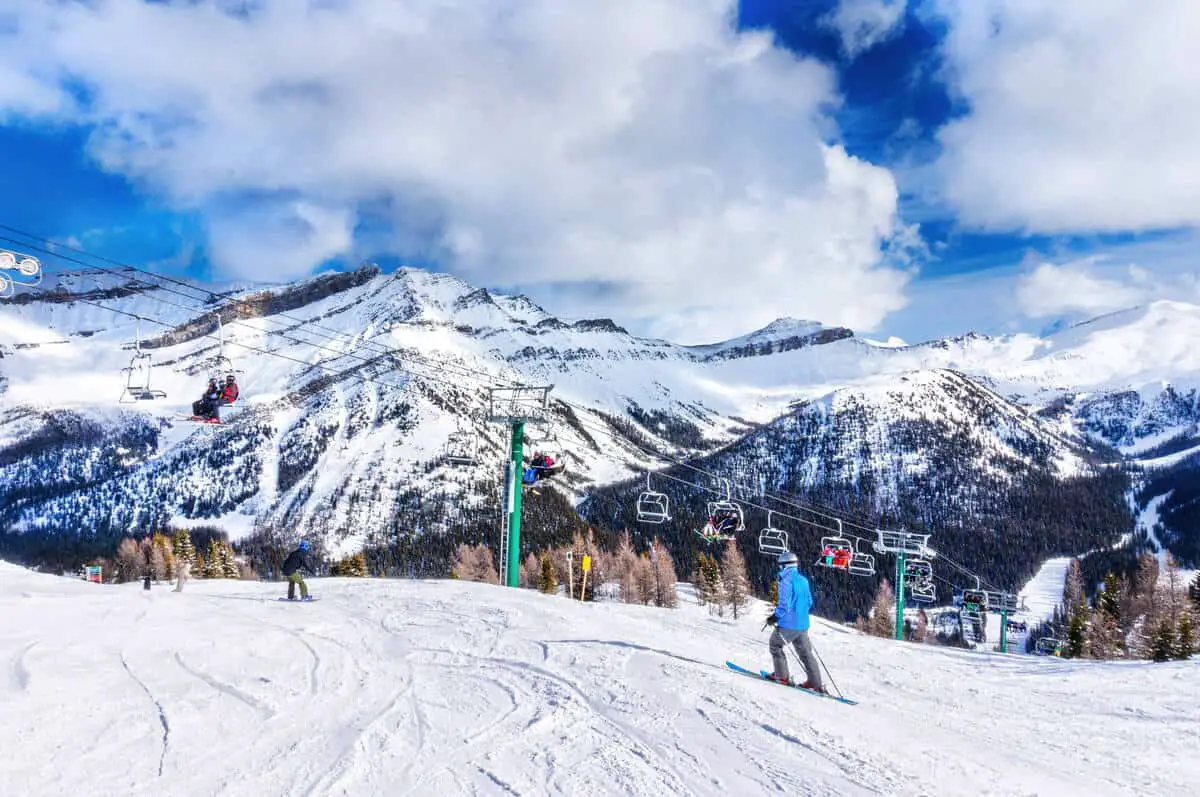Visiting Banff in March means lots of snow and low temperatures. It’s a very good month for skiing and snowboarding, especially because temperatures are getting slightly milder. Not to mention all the other things you can do in Banff in March. Read on to find out!
Even though December, January, and February are the busiest months for skiing and snowboarding in Banff National Park, March might be even better.
The warmer temperatures hint at early spring, making going down the slopes at one of Banff’s three ski resorts even more fun.
If skiing or snowboarding isn’t your thing, there are many other things to do in Banff in March, like ice skating, snowshoeing and riding a fat bike, just to name a few.
Is Banff Worth Visiting in March?
The answer to that question is a plain yes. If you like skiing or snowboarding, March is one of the best times to visit Banff National Park.
But Banff’s is also a fantastic place to stay in March if you like snowshoeing, fat tire biking, ice skating, hiking, and dog sledding.
The snow conditions are generally good, making March an ideal time for winter activities.
Several famous summer attractions, such as the Banff Gondola, the Banff Hot Springs, and Lake Louise, are also accessible in winter.
However, all months have their specific pros and cons. I listed them below to give you a balanced perspective on visiting Banff in March.
Pros and Cons of Visiting Banff in March
| PROS | CONS |
|---|---|
| 1. Lower hotel rates: March is considered a shoulder season in Banff National Park, which means that hotel rates are generally lower than during the peak summer season. This can save you a lot of money on accommodation. | 1. Cold weather: While March is milder than the winter months, it can still be quite cold in Banff National Park. You should be prepared for temperatures below freezing and dress in warm layers. |
| 2. Fewer crowds: Since March is not a peak season, you can enjoy the stunning scenery of Banff National Park without having to deal with large crowds of tourists. This can make your experience more peaceful and enjoyable. | 2. Snowy conditions: March is still a winter month in Banff National Park, which means there can be a lot of snow on the ground. You should be prepared for snowy and icy conditions on the roads and trails. |
| 3. Better availability of tours and activities: Since there are fewer tourists in March, you may find it easier to book tours and activities in Banff National Park. This can give you more options and flexibility in planning your trip. | 3. Limited access: Some roads and trails in Banff National Park may be closed or inaccessible during the winter months due to snow and ice. You need to check road and trail conditions before going out. |
| 4. Winter sports: Banff National Park is known for its winter sports, and March is a great time to enjoy them. You can go skiing, snowboarding, snowshoeing, and ice skating. | 4. Snowstorms: Banff National Park is known for its heavy snowfall during the winter months, which can lead to snowstorms and road closures. You need to be prepared for potential travel disruptions. |
| 5. Hot springs: Banff National Park is home to several hot springs, which are a great way to warm up after a day of outdoor activities. March is a great time to visit them, as they are less crowded than during the summer months. | 5. Limited transportation options: Public transportation options in Banff National Park may be limited in March, which means you may need to rent a car or rely on private transportation. |
| 6. Wildlife viewing: March is a great time to spot wildlife in Banff National Park, as animals come out of hibernation (like bears). You may see elk, deer, bighorn sheep, and even bears. | 6. Risk of avalanches: Banff National Park is known for its avalanche risk during the winter months. You need to be aware of the risk and take necessary precautions when participating in winter sports in March. |
| 7. Longer days: In March, the days start to get longer, which means you have more time to explore Banff National Park and enjoy outdoor activities. | 7. Limited access to attractions: Some attractions in Banff National Park, such as the gondola and some museums, may have limited hours or be closed in March. |
| 8. Spring weather: While March can still be cold in Banff National Park, the weather is generally milder compared to the winter months. You can expect temperatures to range from -5°C to 5°C, with occasional warm spells. | 8. Risk of road closures: With heavy snowfall and potential snowstorms, some roads in Banff National Park may be closed or have limited access during February. You need to check road conditions before planning your activities and be prepared for potential travel disruptions. |
| 9. Photography opportunities: March offers great photography opportunities in Banff National Park, with the snow-capped mountains and frozen lakes providing stunning backdrops. | 9. Limited restaurant options: Some restaurants and cafes in Banff National Park may be closed in March. |
Banff Weather in March
If you plan a trip to Banff in March, it’s important to know what weather to expect. Banff is a beautiful place to visit any time of year, but March is one of the snowiest months, although the first hints of spring are beginning to emerge.
Average Temperature in Banff in March
March is one of the coldest months to visit Banff, with an average high temperature of 5.2°C (41.4˚F), but it can get (much) colder. The daily mean temperature is -0.7˚C (30.7˚F).
So while March shows the first sign of spring, with relatively mild weather conditions, be prepared for cold weather and dress appropriately in warm layers and winter gear.
Snowfall and Precipitation in Banff in March
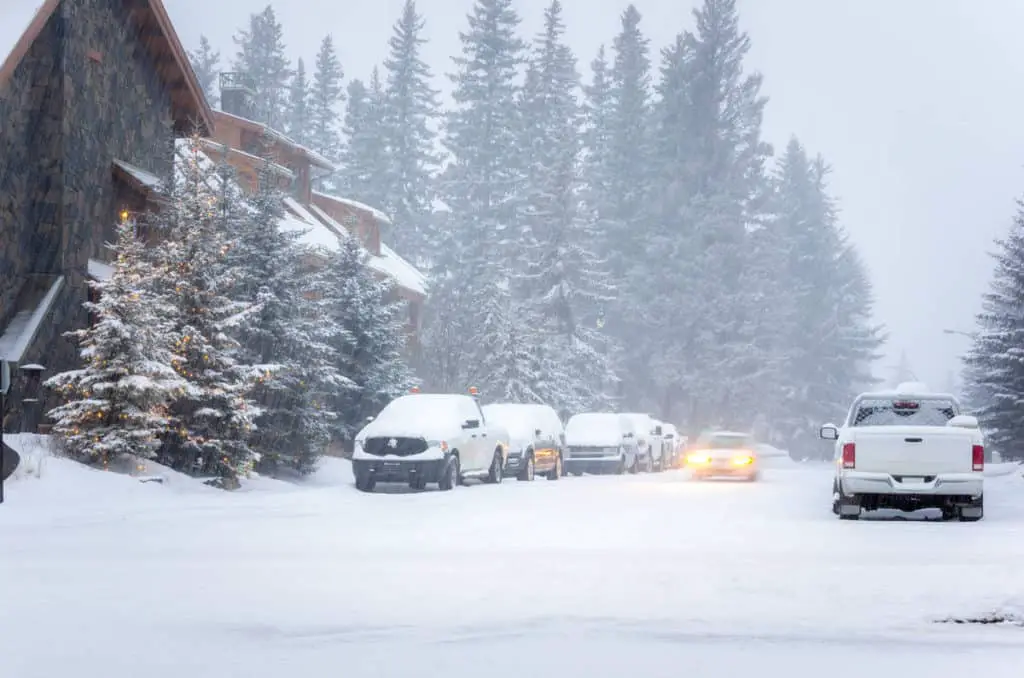
March is a great time to visit Banff if you enjoy winter sports. Even though spring is looming with an average daily high of 5.2˚C (41.4˚F), there is usually still a good base of snow for skiing, snowboarding, snowshoeing, and winter hiking.
Hence, you can expect more average snowfall in March than in February. The month sees an average snowfall of 27.2 centimeters (10.71 in) during March, but this can vary from year to year.
Furthermore, March sees an average of 21.2 snowfall days. That’s also more than in February (18.8 days on average).
It is essential to check the weather forecast and road conditions before traveling to Banff during this time of year, as snow and ice can affect driving conditions.
What Is a Chinook Wind?
When visiting Banff in March, you might experience a Chinook wind. This strong, warm, and dry wind can shift the temperature by 20°C (59°F) within a day.
While it can be a welcome relief from the cold, it can also cause rapid snow and ice melting, leading to flooding and other hazards. So be prepared for sudden temperature and weather changes if you visit Banff in March.
Wanna know more about the climate in the Park? Check out the post that discusses everything about weather in Banff National Park.
What to Pack for Banff in March
Packing to visit Banff in March involves a bit more than visiting the park in summer. You need to bring suitable clothing to withstand the sometimes extreme weather.
Clothing
Despite March showing the first signs of spring, it is still important to pack warm clothing when visiting Banff this month. The temperature can drop to -15°C (5°F) or lower, so you’ll want to dress in layers to stay warm.
At the very least, bring the following items:
- Proper winter jacket
- Warm (ski) pants
- Sweater
- Thermal underwear
- Merino wool socks
- Winter boots
- Gloves
- Hat
- Scarf
Gear
Aside from warm clothing, you’ll also want to pack some gear. Here are some items you should consider bringing:
- Daypack to carry water, snacks, and extra layers
- Snowshoes or crampons for hiking in the snow
- Ski or snowboard equipment if you plan to hit the slopes
- Ice skates if you want to skate on frozen lakes
- Compass
- Goggles or sunglasses to protect against the glare of snow
- A camera to capture the stunning winter scenery
- Physical map (cell phone reception in the park is spotty)
Accessories
Don’t forget to pack some accessories to make your trip to Banff more comfortable. Here are some items worth considering for a trip to Banff in March:
- Refillable water bottle to stay hydrated
- Small first aid kit for emergencies
- Sunblock and UV-blocking lip balm to protect your skin from the sun’s harmful rays
- Moisturizer to keep your skin from drying out in the cold weather
- Safety gear such as a compass, knife, and bear spray if you plan to hike
Driving to Banff in March
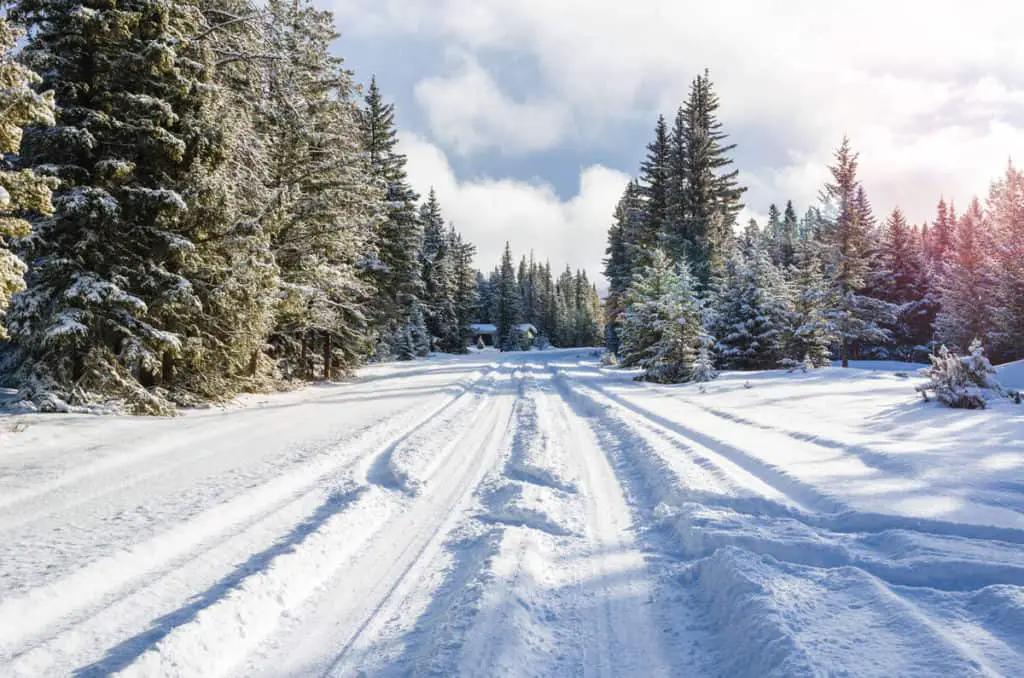
Driving to Banff in March can be challenging due to winter weather conditions. Here are some things to keep in mind when driving to Banff in March:
- Winter Tires: It is essential to have winter tires on your vehicle when driving to Banff in March. Winter tires provide better traction and handling in snowy and icy conditions. Ensure your winter tires are in good condition and adequately inflated before hitting the road. If you have a rental car, ask the rental company about it.
- Check Road Conditions: Before embarking on your journey, check the road conditions and weather forecast. Alberta 511 is an excellent resource for the province’s current road conditions and closures. You can also call 511 toll-free for road condition updates or keep up to date through their app.
- Drive Slowly and Carefully: Snow and ice can make roads slippery and reduce visibility. Drive slowly and carefully, and increase your following distance for more stopping time. Avoid sudden movements, such as hard braking or sharp turns, which can cause your vehicle to lose traction and spin out of control.
- Carry Chains: If you are driving in the mountains, carrying chains is essential when encountering heavy snow or icy conditions. Chains can provide extra traction and help you navigate steep inclines and declines. In Banff, driving with chains in the mountains is mandatory in certain areas. They are lawfully required when driving to the Icefields Parkway (Highway 93 North), Banff-Windermere Highway (Highway 93 South), and most other roadways, except for Highways 1 and 16.
- Fill Up Your Gas Tank: Make sure you have a full gas tank before heading out. Gas stations are scarce in the park, and you don’t want to run out of gas in the middle of nowhere when it’s freezing cold.
- Be Prepared: In addition to winter tires and chains, carrying a winter survival kit in your vehicle in an emergency is a good idea. Your kit should include blankets, warm clothing, food, water, a flashlight, and a first aid kit.
Wanna know more? Check out my post on winter driving in Banff.
Things to Do in Banff in March
Visiting Banff in March means snow-covered mountains, crisp air and a picturesque backdrop for outdoor activities.
Here are some reasons why you should consider visiting Banff in March:
Skiing and Snowboarding in Banff in March
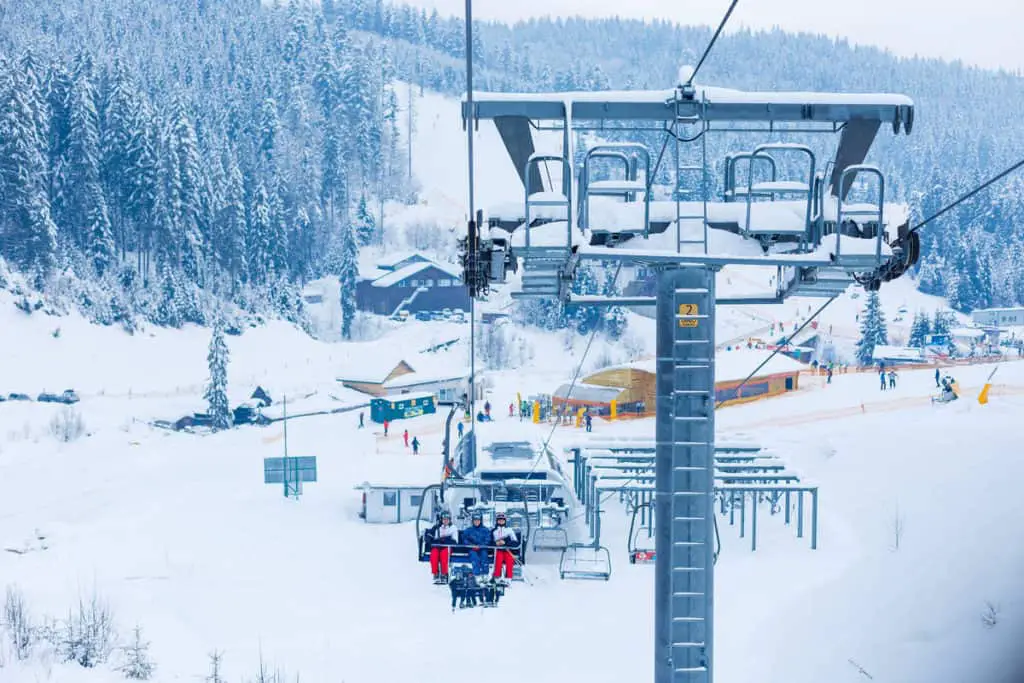
If you’re a skiing or snowboarding enthusiast, Banff in March is the perfect time to hit the slopes. With an average temperature of -1℃ (30°F), the snow conditions are ideal for skiing and snowboarding.
Banff’s three ski resorts (Mt. Norquay, Lake Louise and Sunshine Village) offer a variety of trails for all levels of
experience, from beginner to advanced.
I recommend Lake Louise Ski Resort for its breathtaking views and wide range of runs.
In March, the ski season is still in full swing. Many resorts provide excellent deals on lift tickets and accommodation during this time.
Enjoy Après Ski in Banff in March
After a day on the slopes, head to one of Banff’s many après ski spots to relax and enjoy Banff’s energetic nightlife. Banff has plenty of bars, restaurants, and pubs. Some popular spots include the Banff Ave Brewing Co., Park Distillery, and the Rose and Crown.
Ice Skating in Banff in March
Ice skating is a classic winter activity, and Banff has several outdoor rinks. A popular rink is the Banff Skating Rink near the Banff train station. The rink is open daily from 10 am to 9 pm, and skate rentals are available on-site.
If you’re lucky – in case there’s not too much snow on the ice – you can also skate on one of the many lakes in the park, like Two Jack Lake, Jonson Lake, Cascade Ponds, Lake Minnewanka and the famous Lake Louise.
Ice Skate on Vermilion Lakes
Ice skating on Vermilion Lakes is an excellent way of spending time in March. Use the piers at the lake to put on your skates and easily step onto the ice. The lake is surrounded by the Rockies, like the majestic Mount Rundle, making for picture-perfect scenery.
A bonus is that Vermilion Lakes is within walking distance from the Banff Townsite.
Hiking, Snowshoeing, and Cross-Country Skiing in Banff in March
Consider hiking, snowshoeing, or cross-country skiing if you’re looking for a more low-key winter activity. Banff National Park has over 1,600 kilometers (994 mi) of trails, with options for all skill levels.
Some popular trails include the Johnston Canyon Ice Walk, the Lake Agnes Tea House Hike, and the Spray River Loop.
Hike the Tunnel Mountain Trail
If you’re looking for a fun and accessible hike in Banff in March, you should definitely check out the Tunnel Mountain Trail. This trail is a classic Banff hike that is accessible year-round.
The trail is just 2.15 kilometers (1,234 mi) each way with an elevation gain of 268 meters, (879 ft). You’ll start off in a forest and then make your way up the switchbacks that climb the mountain.
As you make your way up, you’ll encounter plenty of breaks in the trees to enjoy stunning views of the surrounding area. The summit is a great spot to take in the views of Banff and the surrounding mountains like the majestic Rundle Mountain.
In March, there will be a lot of snow on the trail, making it slightly more difficult to reach to the top. But as it’s a reasonably short hike, people of most fitness levels should be able to get there.
Sledding in Banff in March
Sledding is a fun activity for all ages, and Banff has several great sledding hills to choose from. Just take your toboggan, choose a hill that’s steep enough for your desires, and off you go!
Want to know more about sledding in the park? Read my blog post dedicated to this fun winter activity.
Dog Sledding in March
For a truly unique experience, try dog sledding in Banff. Discover Banff Tours offers dog sledding adventures at Lake Louise and in Canmore. This is an absolutely extraordinary way to experience the winter landscape.
Wanna know more about sledding in Banff? Check out Dog Sledding in Banff, the Ultimate Rockies Winter Experience.
Ice Walking and Ice Climbing in Banff in March
Banff offers ice climbing and ice walking tours for the more adventurous type. Ice climbing is a thrilling activity that involves scaling frozen waterfalls and cliffs.
In contrast, ice walking is a more relaxed activity on frozen lakes. Some popular companies that offer ice climbing and ice walking tours include Yamnuska Mountain Adventures and Banff Tours.
Johnston Canyon Icewalk
A cool activity is the Johnston Canyon Icewalk. This guided hike takes you along a catwalk through Johnston Canyon. You’ll see frozen waterfalls and stunning ice formations. The hike is about 5.4 kilometres (3.4 mi) roundtrip and is considered easy to moderate.
Visit the Hot Springs in Banff in March
After a day of outdoor activities, relax in Banff’s famous hot springs. The Banff Upper Hot Springs are just a few minutes from downtown Banff and offer stunning views of the Rockies.
The hot springs are open daily from 10 am to 10 pm. Highly recommended!
Wanna know more about the soothing effect of hot springs? Check out my comprehensive post on hot springs in the Banff area.
Visit Banff’s Famous Lakes in March
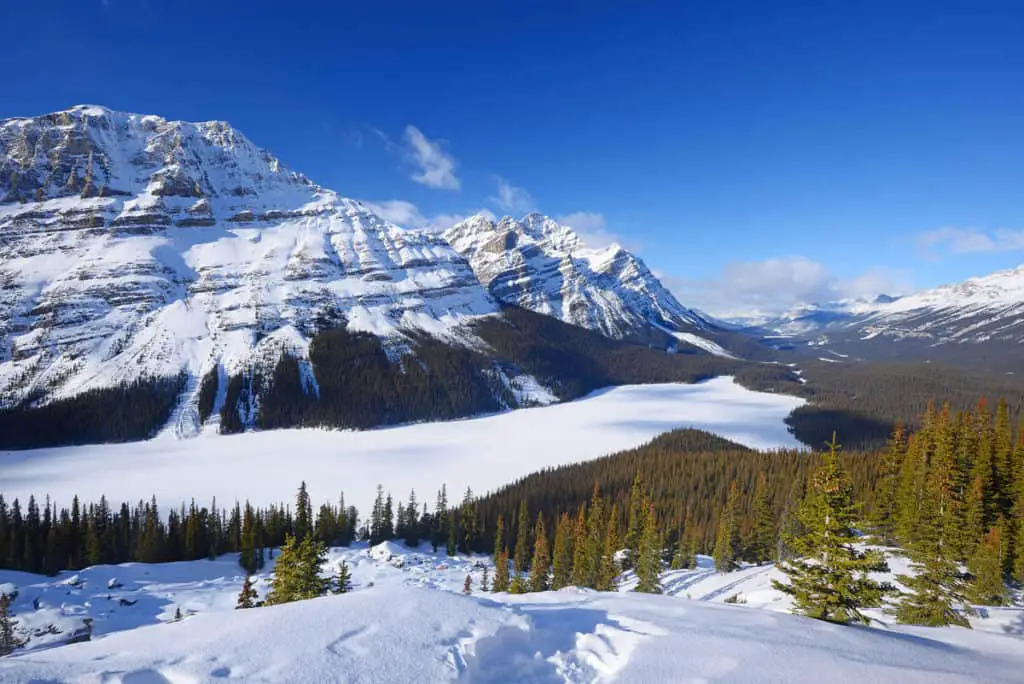
While Banff National Park’s famous lakes are mainly summer attractions, you can still visit most of them in the winter as they are still accessible at this time of the year.
Can You Visit Lake Louise in March?
Yes, you can definitely visit Lake Louise in March! March is a great time to visit Lake Louise, as the winter season is still in full swing and the lake is usually still frozen. March is a great time to enjoy winter activities such as snowshoeing and ice skating at Lake Louise.
Can You Visit Moraine Lake in March?
Unfortunately, the road to Moraine Lake is closed during the winter season due to heavy snowfall and avalanche risk. The road usually closes in mid-October and reopens in late May or early June, depending on weather conditions.
However, if you are an experienced adventurer with avalanche knowledge and snowshoes or skis, it may be possible to access Moraine Lake during the winter. Just be sure to check for any warnings before heading out.
Can You Visit Peyto Lake in March?
Yes, you can visit Peyto Lake in March, but accessing the lake may be more difficult due to winter road closures, depending on weather conditions. However, if the road is open, March can be a great time to visit Peyto Lake, as the winter scenery is stunning.
Do a Helicopter Tour in Banff in March
If you want to see Banff from a different perspective, consider taking a helicopter tour. They offer breathtaking views of the Rockies and are a great way to see Banff’s stunning scenery from above.
A helicopter trip in March means a stunning white landscape that delivers an entirely different view of the park than in summer. It’s absolutely stunning!
Some popular helicopter tour companies include Alpine Helicopters and Rockies Heli Canada.
The main downside of booking a helicopter tour in March is that cancellations due to severe conditions occur much more often than in the summer.
Wanna read more about helicopter tours in the park? Check out the Ultimate Experience: Book a Helicopter Tour in Banff.
Catch the Northern Lights in Banff in March
If you’re lucky, you may catch a glimpse of the Northern Lights during your visit to Banff. The Northern Lights, also known as the Aurora Borealis, is a natural phenomenon that occurs when charged particles from the sun collide with the Earth’s atmosphere.
The best time to see the Northern Lights in Banff is from December to March, on clear nights away from city lights.
Want to know about aurora borealis in the park? Read the post about the northern lights in Banff National Park.
Wildlife Viewing in Banff in March
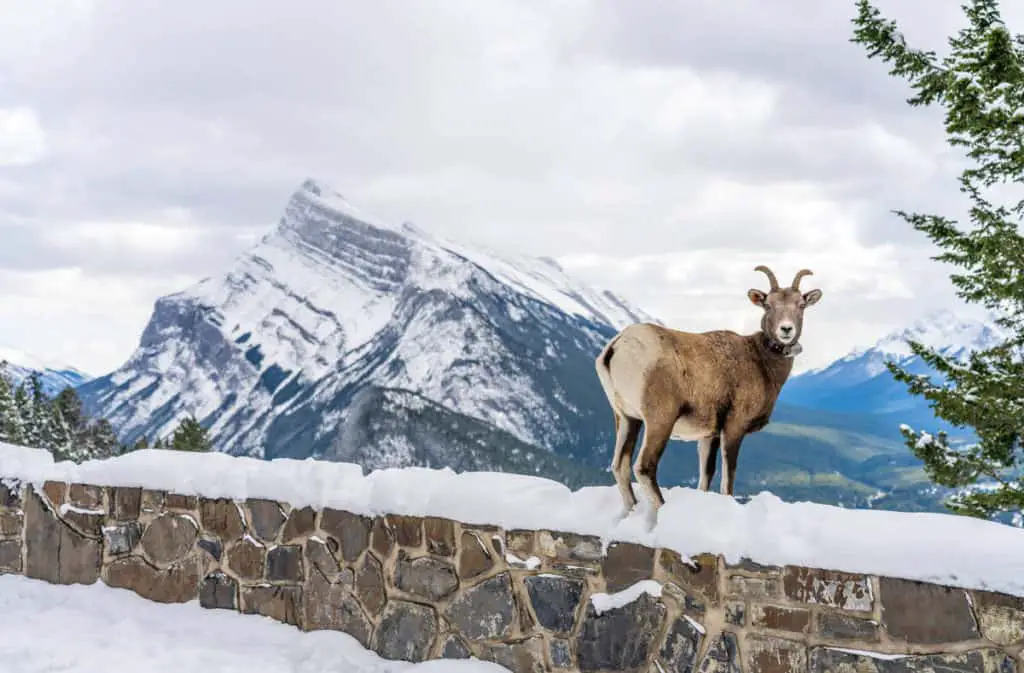
Visiting Banff in March offers a unique opportunity to witness the park’s wildlife. Despite winter’s cold, you can see animals like elk, deer, bighorn sheep, and moose.
The cold temperatures and snow-covered landscape make it easier to spot them.
Enjoy Scenic Views in Banff in March
The snow-covered landscape of Banff in March offers breathtaking scenic views. The mountains, lakes, rivers, and forests provide a serene and peaceful atmosphere.
During my time in Banff, I couldn’t figure out what I found more beautiful: the park in summer or in winter. Still ain’t got it figured out.
In any case, the scenic views are ideal for some stunning Insta-material!
Where to Stay in Banff in March
Banff has many lodging options as a major tourist destination in North America. Check out your possibilities below.
Ski Resorts in Banff in March
If you plan to hit the slopes in Banff in March, you may consider staying at one of the area’s ski resorts.
Sunshine Village and Lake Louise Ski Resort offer on-site accommodations, making getting from your room to the lifts easy.
At Lake Louise, you can stay at the Fairmont Château Lake Louise, located close to the ski hills. This luxurious resort hotel offers extensive amenities, including a spa and several dining options.

Mt. Norquay also has a range of accommodation options, including the Juniper Hotel and Bistro, just a few minutes from the ski hill. The hotel offers stunning views of the surrounding mountains and various amenities, including a hot tub and sauna.
Banff Sunshine is also very popular. The Sunshine Mountain Lodge is located at the base of the ski hill, offering the only ski-in/ski-out access in Banff National Park. The lodge also has several dining options and a range of other amenities, including a sauna and an outdoor hot tub.
Hotels and Lodges in Banff in March
Banff has plenty of options if you’re looking for a more traditional hotel or lodge experience.
The Banff Springs Hotel is one of the most iconic hotels in the area, offering a range of luxurious amenities, including a spa, several bars and restaurants, and stunning views of the mountains.
The same goes for the Fairmont Château Lake Louise.
The Rimrock Resort Hotel is another popular option with amenities like a spa, indoor pool, and several restaurants. Like the Banff Springs Hotel, the Rimrock is just a few minutes from downtown Banff.
For a more rustic experience, the Storm Mountain Lodge is a great option. The lodge is located about an hour outside the town of Banff, but it offers a range of cozy cabins and lodges, as well as a restaurant that serves up delicious meals made with all Canadian ingredients.
Hostels and Campgrounds in Banff in March
If you’re traveling on a budget, several hostels and campgrounds in the Banff area offer affordable accommodation options. The Samesun Banff is one of the most popular hostels in the area, offering a range of dorm and private rooms and a communal kitchen and lounge area.
The Tunnel Mountain Campground is another popular option for budget travelers. The campground is just a few minutes from downtown Banff and offers campsites for tents and RVs.
Want to read about your options for winter camping in the park? Check the post Winter Camping in Banff.
Getting Around Banff in March
Car Rental in Banff in March
Without a doubt, the best way to get around Banff in March is by renting a car. This will give you the most flexibility in terms of where you can go and when you can go there.
However, driving in winter can be challenging (see above), especially if you are not used to it. Make sure to rent a car with winter tires.
Banff has several car rental companies, including Budget, Enterprise Rent-a-Car, Hertz, Alamo and Avis. Prices can vary, so I’d suggest you shop around and compare prices before making a reservation.
Public Transportation in Banff in March
If you don’t want to rent a car, several public transportation options are available in Banff. Roam Transit operates year-round and serves Banff, Canmore, and Lake Louise.
In March, several bus routes can take you to popular destinations, such as Banff Gondola, Lake Louise, and Johnston Canyon.
The schedules and routes may change, so check the Roam Transit website for the latest information.
Several routes operate on a reduced schedule in March, so check the schedule before you go.
Another option is the Parks Canada shuttle service, which operates between Banff and the Lake Louise Ski Resort. Ski shuttles are free for anyone with a valid lift ticket.
This service is free in winter but can be crowded, so be prepared to wait in line.
Taxis in Banff in March
Taxis are a good option if you need to get somewhere quickly and don’t want to wait for public transportation. Banff has two taxi companies, Banff Taxi and Taxi Taxi.
Prices can vary depending on the distance you need to travel and the time of day, so ask for an estimate before you get in the cab.
In any case, cabs are expensive in Canada. Just so you know.
Festivals and Events in Banff in March
The festivals and events in the Banff area really start to wind down in March. There’s nothing noteworthy organized except one celebration (see below).
St. Patrick’s Day Celebrations
Several bars and restaurants in Banff offer St. Patrick’s Day specials on March 17th, including Irish food and drink specials and live music.
Of course, you can count on Banff’s Irish pub, St James’s Gate, to celebrate St. Patrick’s Day, as it’s an Irish celebration. You can find St James’s Gate at 207 Wolf Street in Banff.
Summer Attractions Also Open in Banff in March
While Banff is known for its summer activities, some summer attractions are also accessible in March.
1. Banff Gondola
One of the most popular summer attractions that remains open year-round is the Banff Gondola.
It takes you to the top of Sulphur Mountain, where you can enjoy stunning views of the surrounding mountains and valleys. You can also snowshoe or hike to the summit in the winter if you want a more adventurous experience.
2. Cave and Basin National Historic Site
The Cave and Basin National Historic Site is a popular attraction in the summer, but it is also open in March. This is where Banff National Park was born, and it is a great place to learn about the park’s history.
You can explore the cave and basin, take a guided tour, and learn about the geothermal features of the area.
3. Johnston Canyon
If you enjoy hiking, the Johnston Canyon trail is a must-see. The trail takes you through a canyon with frozen waterfalls and ice formations.
The trail is covered in snow and ice in winter, making it a unique and challenging hike. You can also take a guided canyon tour to learn about all the canyon’s ins and outs.
Statutory Holidays in Banff in March
There are no statutory holidays in March in Alberta.
Visiting Banff in February FAQ
What’s the Best Time of the Year to Visit Banff?
Banff is a beautiful destination year-round, so the best time to visit really depends on your interests and what you want to do while you’re there.
If you’re interested in hiking and outdoor activities, then June through Mid-September are a great time to visit. The weather is warm and the days are long, so you’ll have plenty of time to explore the area’s trails and lakes.
If you’re interested in skiing and winter sports, then the winter months of December through March are the best time to visit. The snow is at its best during this time, and you’ll have three ski resorts in the area to choose from.
WEATHER IN BANFF, CANADA: AVERAGE TEMPERATURE

When Is the Shoulder Season in Banff?
The shoulder season in Banff is typically in the spring and fall months. During this time, the crowds are smaller and the prices are lower, making it a great time to visit if you’re looking for a more affordable and peaceful vacation.
The months of May and September are particularly good times to visit, as the weather is not too cold or even pleasant and there are plenty of outdoor activities to enjoy.
What Time Does it Get Dark in Banff in March?
In March, the days are getting significantly longer in Banff. The sun sets between 6.22 pm (1 March) and 8.13 pm (31 March), so it gets dark quite early. There’s such a big difference between the first and last day of the month because the clocks changes forward 1 hour in March.
Can You Go to Banff in March?
Yes, you can definitely go to Banff in March! March is still very much winter in Banff, and there is still plenty of snow on the ground. So be sure to pack warm clothing. There are also plenty of winter activities to enjoy in Banff during March, such as skiing, snowboarding, snowshoeing and ice skating.
When Is the Skiing Season in Banff?
The skiing season in Banff typically runs from late November through early May, depending on the weather and snow conditions. The peak season for skiing is usually in January and February, when the snow is at its best and the ski resorts are busiest.
However, there are plenty of opportunities to ski and snowboard throughout the entire season, so you can plan your visit based on your schedule and preferences.
Banff Travel Guide
Where Is Banff National Park, Canada?
Banff National Park is in the southwest of the province of Alberta. It’s home to the towns of Banff and Lake Louise and borders the province of British Columbia in the west of Canada. You can easily access famous places like Lake Louise, Moraine Lake, Peyto Lake and the stunning Icefields Parkway from these locations.
Banff and Lake Louise are situated in the Rocky Mountains of Alberta, close to the boundary with British Columbia, as shown on the map of Banff National Park below.
Is Banff, Canada safe?
Generally speaking, yes. Like most areas, Banff has crime, but it’s still a safe travel place. But Banff has a lot of wildlife, including bears and cougars, so you should always carry bear spray and exercise caution when hiking in the mountains.
How Do I travel to Banff, Canada?
Want to fly to Banff? Calgary International Airport (Code: YYC) is the closest airport. It’s 130 kilometers (81 mi) to the east of Banff.
Several cities, including Toronto, Chicago, Seattle, and Dallas/Fort Worth, have direct flights into Calgary.
Pick up a rental vehicle at Calgary International Airport, or take a private transport service to your destination. The trip to the park takes about 1 hour and 40 minutes.
Viator has several good options. Click the link to check the options and latest rates.
Banff Car Rental
Want to rent a car during your stay in Banff National Park? Rent one at Calgary International Airport or in the city of Calgary. Yep, there are rental firms in Lake Louise and Banff, but as these are small towns, your rental options can be limited.
Avis is a reputable car rental company, which I’ve used many times. Book now with Avis.
Banff Travel Planning Guide
Do I need a visa for Banff?
Most likely not. Citizens of the US, most European countries, Australia and New Zealand don’t need a visa to enter Canada. Not sure? Click the link to see whether you need a visa or not. The typical length of stay in Canada for people with visa-exempt passports is 90 days.
Do I need travel insurance for Banff?
You bet. Feel confident while traveling with a plan from Travel Insurance Master, one of the top names in travel insurance, for just USD 10 on average per day.
What’s the best way to book my Banff accommodation?
If you plan to book a hotel, hostel or bed & breakfast, Booking.com is your best bet. It has the most hotels listed and often offers the best rates.
Do I need to rent a car in Banf?
Absolutely. While Banff is one of the few national parks in North America with a sizeable public transport network, I strongly advise renting a car if you want to make the most of your visit.
Will my phone work in Banff?
It depends. In the towns of Banff and Lake Louise, you should have good to excellent reception. However, in more remote areas, the signal is spotty. In many places, there will be no signal at all.
What’s the best site to buy Banff flights?
If you’re looking for cheap flights to Banff, I recommend Skyscanner. No surprises with suddenly increased rates (for taxes, seats or luggage) upon checkout. What you see is what you get.
If Visiting Banff in March Isn’t for You…
After reading this you might decide not to go to Banff in March after all. If so, check out the articles linked below about traveling to Banff during other months.

